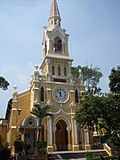
French colonial architecture includes several styles of architecture used by the French during colonization. French colonial architecture has a long history, beginning in North America in 1604 and being most active in the Western Hemisphere (Caribbean, Guiana, Canada, Louisiana) until the 19th century, when the French turned their attention more to Africa, Asia, and Oceania. [1]
Contents
- In Africa
- French Equatorial Africa
- French North Africa
- French West Africa
- In Asia
- Cambodia
- China
- Laos
- Vietnam
- In North America
- Canada
- United States
- See also
- References
Many former French colonies, especially those in Southeast Asia, have previously been reluctant to promote their colonial architecture as an asset for tourism; however, in recent times,[ when? ] the new generation[ which? ] of local authorities has somewhat "embraced" the architecture and has begun to advertise it. [2]




































































